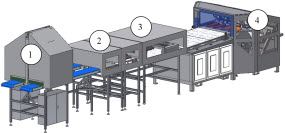Previous systems for pre-rigor pin bone removal have removed the bones by cutting with a knife into the fillet from above. This leaves a large scar on the fillet or divides the fillet in two. Other systems have simply focused on detecting the presence of pin bones using X-rays, without attempting to automatically remove the bones. The use of X-ray makes the system prohibitively expensive.
Trio Food Processing Machinery AS, a Norwegian company, has developed a system that allows the pin bones to be removed from fish fillets while they are still in the pre-rigor phase, not more than one to two hours after the slaughtering. By cutting the soft root of the pin bones the force needed to extract the bones is reduced by approximately 50%. The cut is performed by inserting a long thin knife from the head end of the fillet close to the skin. The knife is inserted in such a way that the tip of the knife follows a trajectory where the tendons are estimated to be located, and thus cuts the tendons. The pin bones can not be seen directly on the outside of the fillet. It was thus necessary to estimate the location of the tendon attachment based on features on surface of the fillet. One alternative could be to detect the bone ends and use those to position the cut. The bone ends are however also often well hidden into the flesh, which makes any detection of them difficult and unreliable.
SINTEF has therefore developed a machine vision system that detects the positions of a line-looking texture pattern on the surface of the fillet. This line is empirically shown to be well co-located with the line of tendons deep in the flesh.
The project was done in close collaberation with SINTEF Fisheries and Aquaculture, which provided the know-how on salmon anatomy and handling. This collaboration was crucial during the system design, where both knowledge of fish anatomy and robust machine vision algorithms was used during evaluation of alternative system designs.

Illustration of pinbone removal system. 1) Machine vision solution indicating pinbone position. 2) Fish positioning system. 3) Pinbone cutting system. 4) Pinbone removal system.
